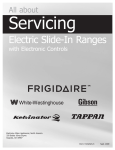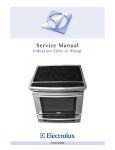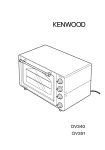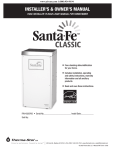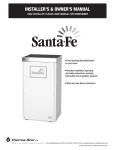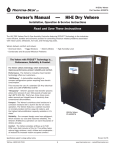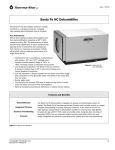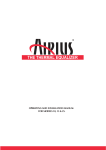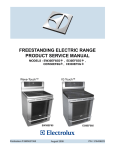Download SERVICE DATA SHEET 318127078 (1003) Rev. A
Transcript
SERVICE DATA SHEET 318127078 (1003) Rev. A Electric / Gas / Dual Fuel Slide-In Range with Electronic Oven Control NOTICE This service data sheet is intended for use by persons having electrical and mechanical training and a level of knowledge of these subjects generally considered acceptable in the appliance repair trade. The manufacturer cannot be responsible, nor assume any liability, for injury or damage of any kind arising from the use of this data sheet. SAFE SERVICING PRACTICES To avoid the possibility of personal injury and/or property damage, it is important that safe servicing practices be observed. The following are examples, but without limitation, of such practices. 1. Do not attempt a product repair if you have any doubts as to your ability to complete it in a safe and satisfactory manner. 2. Before servicing or moving an appliance, remove power cord from electric outlet, trip circuit breaker to OFF, or remove fuse and turn off gas supply. 3. Never interfere with the proper installation of any safety device. 4. USE ONLY REPLACEMENT PARTS CATALOGED FOR THIS APPLIANCE. SUBSTITUTIONS MAY DEFEAT COMPLIANCE WITH SAFETY STANDARDS SET FOR HOME APPLIANCES. 5. GROUNDING: The standard color coding for safety ground wires is GREEN OR GREEN WITH YELLOW STRIPES. Ground leads are not to be used as current carrying conductors. IT IS EXTREMELY IMPORTANT THAT THE SERVICE TECHNICIAN REESTABLISH ALL SAFETY GROUNDS PRIOR TO COMPLETION OF SERVICE. FAILURE TO DO SO WILL CREATE A POTENTIAL HAZARD. 6. Prior to returning the product to service, ensure that: • All electric connections are correct and secure. • All electrical leads are properly dressed and secured away from sharp edges, high-temperature components, and moving parts. • All non-insulated electrical terminals, connectors, heaters, etc. are adequately spaced away from all metal parts and panels. • All safety grounds (both internal and external) are correctly and securely reassembled. • All panels are properly and securely reassembled. ELECTRONIC OVEN CONTROL (ELECTRIC AND DUAL FUEL RANGES) 1. This self-cleaning controller offers Bake, Broil, Convection Bake, Convection Roasting and Convection Broil modes, Dehydrating, Defrosting, Temperature Probe, Perfect Turkey, Bread Proof, Keep Warm and Cleaning functions. 2. Convection operates with an element and a fan dedicated to convection. 3. This controller includes a display board, a relay board, and a convection fan and oven light control board. NOTE: The controllers are not field repairable. Only temperature settings can be changed. See oven calibration. Printed in the United States ELECTRONIC OVEN CONTROL (GAS RANGES) 1. This self-cleaning controller offers Bake, Broil, Convection Bake and Convection Roasting, Dehydrating, Defrosting, Temperature Probe, Perfect Turkey, Bread Proof, Keep Warm and Cleaning functions. 2. Convection operates with an element and a fan dedicated to convection. 3. This controller includes a display board, a relay board, and a convection fan and oven light control board. NOTE: The controllers are not field repairable. Only temperature settings can be changed. See oven calibration. ELECTRONIC OVEN CONTROL RELAY BOARD FOR ELECTRIC AND DUAL FUEL RANGES P10 P2 P18 P4 J4 P6 K6 J7 K2 J6 J5 P5 K3 K5 K7 P7 P9 P11 J2 K1 P3 P17 Relay Board Legend: K1.Double Line Break - Upper Oven K2.Double Line Break - Lower Oven K3.Broil Relay - Upper Oven K5.Bake Relay - Upper Oven K6.Bake Relay - Lower Oven K7.Convection Element Relay - Upper Oven K11.Motor Door Latch - Upper Oven K16.Cooling Fan Relay 1 - Upper Oven K18.Cooling Fan Relay 2 - Upper Oven K16 K11 P1 K18 J3 This relay board serves to energize the upper and lower oven heating elements, door lock motor and cooling fan. P1 - L2 Out, Upper Oven P2 - L2 Out, Lower Oven P3 - L2 In, Upper Oven P4 - Not Used P5 - L1, Upper Oven P6 - L1, Lower Oven P7 - Broil, Upper Oven P9 - Bake, Upper Oven P10 - Bake, Lower Oven P11 - Convection Element, Upper Oven P17 - Not Used P18 - L2 In, Lower Oven J2 - DC Power Output To Display Board J3 - AC Power Output (motor door latch, cooling fan) For Upper Oven J4 - Power Input (L1, Neutral) J5 - Relay Control Inputs (bake, broil and convection elements, motor door latch, DLB) For Upper Oven J6 - Relay Control Inputs (cooling fan) For Upper Oven J7 - Relay Control Inputs (bake element and DLB) For Lower Oven 2 ELECTRONIC SURFACE ELEMENT CONTROL (ESEC) - ELECTRIC MODEL ONLY - User Interface Board (UIB) Legend: J2. Connector for Touch Panel LEDs and Display Indicators J3. Connector for Touch Panel LEDs and Display Indicators J4. Connector for Keyboard (Touch Panel) P3.Micro Programming Header (Not Used) P5. Connector for the hot element indicators from Relay Board P6.Power Supply Input (from relay board) P7.Power Supply Input (from power supply board for touch panel LEDs) P9.Communication with Oven Control P10. Surface Elements Relay Controls User Interface Board (UIB) ESEC Relay Board Legend: P1.Right Front Inner Element Connection P2.Line In (120V AC) P3.Line In (120V AC) P4.Right Front Outer Element Connection P5.Left Front Inner Element Connection P6.Line In (120V AC) P7.Left Front Middle Element Connection P8.Line In (120V AC) P9.Left Front Outer Element Connection P10. Right Rear Element Connection P11. Line In (120V AC) P12. Right Rear Outer Element Connection P13. Line In (120V AC) P14. Left Rear Element Connection P15. Center Rear Element Connection P16. Line In (120V AC) P17. Not Used ESEC Relay Board K1. Right Front Inner Element Relay K2. Right Front Outer Element Relay K3. Left Front Inner Element Relay K4. Left Front Middle Element Relay K5. Left Front Outer Element Relay K6. Right Rear Inner Element Relay K7. Right Rear Outer Element Relay K8. Left Rear Element Relay K9. Center Rear Element Relay J1. Line Voltage Input (120V, Neutral) J2. Low Voltage Supply Output For UIB J3. Surface Element Relay Control Inputs J4. Surface Element Hot Signal Inputs J5. Hot Element Signals to UIB 3 ELECTRONIC CONTROL DISPLAY BOARD FOR ELECTRIC AND DUAL FUEL RANGES Electronic oven display board for electric ranges Electronic oven display board for dual fuel ranges Connector Legend: P1 - Upper Oven Probe Input P2 - Communication with Convection Fan and Oven Light Control Board, Communication with ESEC30 UIB (electric only) P3 - Keyboard (touch panel) P6 - Microprocessor Programming (not used) P7 - Touch Panel LEDs P8 - Power Supply Input for Display LEDs P9 - Relay Control Output (heating elements, DLB, motor door latch) for Upper Oven P10 - Switches Input (motor door latch switch, door switch, rack switch) for Upper Oven P11 - Relay Control Output (heating element, DLB) for Lower Oven P13 - Relay Control Output (cooling fan) P16 - DC Power Supply Input P18 - Meat Probe Input P20 - Lower Oven Probe Input POWER SUPPLY BOARD This board provides power to the oven control display. P1 - AC Power Input (L2 and Neutral) P1 P2 - DC Power Output P2 CONVECTION FAN AND OVEN LIGHTS CONTROL BOARD P2 This board control the power output of the convection fan and oven lights. P1 - Communication with display board and power supply input P2 - AC power output for convection fan and oven lights, power inputs (L1, neutral) P6 - Microprocessor programming (not used) Q4 U2 U1 U4 P1 4 Q3 P6 ELECTRONIC OVEN CONTROL RELAY BOARD FOR GAS RANGES J4 J6 J5 P5 K3 K5 K7 P7 P9 P11 Relay Board Legend: K3.Broil Relay K5.Bake Relay K7.Convection Element Relay K11.Motor Door Latch K16.Cooling Fan Relay 1 K18.Cooling Fan Relay 2 K19.Convection Element Relay K20.Warmer Drawer Element Relay J2 K11 K16 J3 K18 K19 K20 P15 This relay board serves to energize the oven heating elements, door lock motor and cooling fan. P5 - L1 P7 - Broil P9 - Bake P11 - Convection Element P15 - L1 J2 - DC Power Output To Display Control Board J3 - AC Power Output (motor door latch, cooling fan, convection element, warmer drawer element) J4 - Power Input (L1, Neutral) J5 - Relay Control Inputs (bake and broil burners, motor door latch, DLB) J6 - Relay Control Inputs (cooling fan, conv element, warmer drawer element) ELECTRONIC OVEN CONTROL DISPLAY BOARD FOR GAS RANGES Connector Legend: P1 - Oven Probe Input P2 - Communication with Convection Fan and Oven Light Control Board P3 - Keyboard (touch panel) P6 - Microprocessor Programming (not used) P7 - Touch Panel LEDs P8 - Power Supply Input for Display LEDs P9 - Relay Control Output (bake and broil burners, DLB, motor door latch) P10 - Switches Input (motor door latch switch, door switch, rack switch) P13 - Relay Control Output (cooling fans, convection element, warmer drawer element) P16 - DC Power Supply Input P18 - Meat Probe Input 5 CONVECTION MODE The convection oven uses the addition of a fan and an element to heat and to move the air already in the oven. Moving the heated air helps to destratify the heat and cause uniform heat distribution. The air is drawn in through a fan shroud and the element located on the rear wall of the oven. It is then discharged around the outer edges of this shroud. The air circulates around the food and then enters the shroud again. As with conventional electric wall ovens, there is still an oven vent which discharges above the door. In preheat of non-convection cooking modes, the convection fan will be operating until the oven has reached the target temperature. To set the control in convection mode, follow these steps: UPPER 1. Select upper oven by pressing UPPER OVEN OVEN . 2. Press CONVECTION BAKE 3. Press START 4. Press CANCEL or CONVECTION ROAST or CONVECTION BROIL . . The oven will automatically start and the fan will begin to run. to stop or cancel the Convection feature at any time. NOTE: The fan runs continuously while in the convection mode. The fan will stop if the door is opened while convection baking/roasting/broiling. The convection element will stop operating if the door is opened. The speed of the convection fan will vary depending on which cooking function is used. Convection Roast uses a fast fan speed, while convection bake uses a slower fan speed. CONVECTION FAN MOTOR The 120V fan motor is located on the outside of the rear of the oven. The fan motor runs continuously while in convection mode unless the door is opened. It is normal to see the fan speed changing depending on the cooking function that is used. This appliance uses the optimum fan speed for each convection function. It is the Convection Fan and Oven Lights Control Board that modulates the speed of the convection fan. It uses the fan speed information communicated by the display board. If the fan does not operate, check the following: - The oven control display will give you an indication on when the convection fan should be on: rotating fan blades in the display means the fan should be ON. No rotating blades mean the convection fan is purposely not used. - Verify proper operation of the door switch. If the control thinks the door is opened the convection fan will not work. If the oven light turns on when the door is opened and turn off when the door is closed then it’s a good indication the door switch is good. - If you are getting an F23 error code it means the display board is not able to communicate with the Convection Fan and Oven Lights Control Board, thus the convection fan will not operate. Check connections between the display board and the Convection Fan and Oven Lights Control Board. Refer to the fault code section for corrective actions. - Check connections on the Convection Fan and Oven Lights Control Board. On connector P2: pin 3 should be Neutral, pin 5 should be L1 (120VAC) and pin 7 should go to the convection fan motor. The other terminal of the convection fan motor should be connected to Neutral. - Fan motor coil resistance should be 15.0 ohm +/- 10% - When the fan is ON you should see between 20 and 120VAC on the motor, depending on the fan speed. - If there is no error code, the wiring is good and the fan coil is good then replace the Convection Fan and Oven Lights Control Board. OVEN CALIBRATION Set the electronic oven control for normal baking at 350°F. Obtain an average oven temperature after a minimum of 5 cycles. The oven calibration can be modified using the oven control display. Please refer to the Owner's Guide manual. Note: Changing calibration affects all the cooking modes but not the clean and the broil modes. FIRST RISE It is normal to see a temperature overshoot in the first rise of all modes when you monitor the temperature. T° First rise overshoot set point t (sec) 6 ELECTRONIC OVEN CONTROL (FAULT CODES) DESCRIPTIONS Note: Generally speaking “F1X” implies a control failure, “F3X” an oven probe problem, and “F9X” a latch motor problem. F10 Control has sensed a potential runaway oven condition. Control may have shorted relay, RTD sensor probe may have a gone bad. 1) Check RTD sensor probe and replace if necessary. If oven is overheating, disconnect power. If oven continues to overheat when power is reapplied, replace relay board and/or display board. F11 Shorted Key: a key has been detected as pressed for a long period and will be considered a shorted key alarm and will terminate all oven activity. 1) Press any key to clear the error. 2) If fault returns, replace the keyboard (touch panel). 3) If the problem persists, replace the display board. F13 Control's internal checksum may have become corrupted. 1) Press any key to clear the error. 2) Disconnect power, wait 30 seconds and reapply power. If fault returns upon power-up, replace display board. F14 Misconnected keyboard cable. 1) Verify connection between display board and touch panel (2 ribbon cables). Make sure the cables are well connected at both ends. 2) If the cables are good, replace the touch panel. 3) If the problem persists, replace the display board. F15 Controller self check failed or terminal cutoff open. 1) An F15 error code on the oven controller may indicate the oven controller is not receiving a synchronization signal from the relay board. One easy way to determine this is to power off the unit, power it on and start a Timer for 1 minute before the F15 error code appears. If the timer counts-down normally then the synchronization signal is okay. If the timer stays at 1:00 and does not countdown, then the synchronization signal is missing. If the synchronization signal is missing, check first if the oven relay board is receiving 120VAC correctly (J4 pin 1 and 3). Then check the wiring between connector J2 on the relay board and connector P16 on the oven controller. If AC power and wiring looks good and the problem is still there, replace the relay board. If problem persists, replace the oven controller. 2) The F15 error code may be caused by an oven controller failure. If the synchronization signal has been verified and tested good, replace the oven controller. F20 The oven controller has detected a problem with the communication link to the surface element controller (ESEC). 1) Is the ESEC User Interface Board powered on (are the surface element displays showing something)? If not, that is the reason why the oven control cannot communicate with it (ESEC has no power). Check the 120VAC voltage going in to the ESEC power supply board located in the front console (connector P1) and the low voltage supply going from the power supply board (connector P2) to the ESEC UIB (connector P8). 2) Check connections between connector P2 on the oven controller and P9 on the ESEC User Interface Board. This is the communication link. Verify for continuity. Refer to the wiring diagram. 3) If the above steps failed to solve the problem, replace the ESEC UIB board. 4) If problem persists replace the oven controller. F23 The controller failed to communicate with the convection fan and oven lights control board. 1) Verify wiring between P2 on the display board and P2 on the convection fan and oven lights control board. 2) If wiring is good, replace convection fan and oven lights board. 3) If the problem persists, replace the display board. F25 No zero cross signal detected on the convection fan and oven lights control board. 1) Make sure L1 and Neutral are connected to the convection fan and oven lights control board on connector P2 (P2 pin 3 = neutral / P2 pin 5 = L1). 2) If problem persists, replace the oven convection fan and oven lights control board. F30 Open RTD sensor probe/ wiring problem. Note: EOC may initially display an "F10", thinking a runaway condition exists. F31 Shorted RTD sensor probe / wiring problem. Note: F30 or F31 is displayed when oven is in active mode or an attempt to enter an active mode is made. 1) Check wiring in probe circuit for possible open condition. 2) Check RTD resistance at room temperature (compare to probe resistance chart). If resistance does not match the chart, replace the RTD sensor probe. 3) Let the oven cool down and restart the function. 4) If the problem persists, replace the display board. F90 Door motor mechanism failure. 1) Press any key to clear the error. 2) If it does not eliminate the problem, turn off power for 30 seconds, then turn on power. 3) Check wiring of Lock Motor, Lock Switch and Door Switch circuits. 4) Unplug the lock motor from the board and apply power (L1) directly to the Lock Motor. If the motor does not rotate, replace Lock Motor Assembly. 5) Check Lock Switch for proper operation (do they open and close, check with ohmmeter). The Lock Motor may be powered as in above step to open and close Lock Switch. If the Lock Switch is defective, replace Motor Lock Assembly. 6) If all above steps fail to correct situation, replace the display board and/or the relay board in the event of a motor that does not rotate. 7) If all the above steps fail to correct the situation, replace the display board in the event of a motor that rotates endlessly. ELECTRONIC SURFACE ELEMENT CONTROL (ESEC- some models) FAULT CODE DESCRIPTIONS E11 Shorted Keypad. Disconnect power, wait 30 seconds and reapply power. If fault returns upon power-up: 1. Replace UIB. 2. Replace Glass Touch Panel E13 Bad EEPROM. Replace UIB (User Interface Board). E14 TST/Display tail missing. Check connection between UIB (connector J2, J3 & J4) & glass touch panel. If connections are good, replace UIB. If problem persist, replace touch panel. E15 ESEC self test failed, or thermal cutoff open. An E15 error code on the ESEC may indicate the User Interface Board is not receiving a synchronization signal from the ESEC relay board. Check first if the ESEC relay board is receiving 120VAC correctly (J1 pin 1 and 3). Then check the wiring between connector J2 on the ESEC relay board and connector P6 on the UIB. If AC power and wiring looks good and the problem is still there, replace the UIB board. If problem persists, replace the ESEC relay board. 7 OVEN TEMPERATURE SENSOR RTD SCALE Temp. °F Temp. °C Resistance (ohms) 32 ± 1.9 0.0 ± 1.1 1000 ± 4.0 75 ± 2.5 23.9 ± 1.4 1091 ± 5.3 250 ± 4.4 121.1 ± 2.4 1453 ± 8.9 350 ± 5.4 176.7 ± 3.0 1654 ± 10.8 450 ± 6.9 232.2 ± 3.8 1852 ± 13.5 550 ± 8.2 287.8 ± 4.6 ELECTRICAL RATING FOR ELECTRIC AND DUAL FUEL OVENS Bake Element Wattage 2500W / 1879W Broil Element Wattage 4000W / 3004W 2047 ± 15.8 Convection Element Wattage 2500W / 1879W 650 ± 9.6 343.3 ± 5.3 2237 ± 18.5 KW Rating See serial plate 900 ± 13.6 482.2 ± 7.6 2697 ± 24.4 ELECTRIC AND DUAL FUEL SLIDE-IN OVEN CIRCUIT ANALYSIS MATRIX On Convection Fan and Oven Lights Control Board On Relay Board ELEMENTS Door DLB Cooling Cooling Bake Broil Conv Motor L2 out Fan Relay 1 Fan Relay 2 P9 P7 P13 J3-5 P1 J3-7 J3-8 Bake X Keep Warm X X X* X Broil Convection Bake X Convection Roast X Bread Proof X Clean X Locking / Unlocking X X X X X X X X X Convection Broil X Conv Fan P2-7 Light P2-1 On Display Board Door Switch P8-3 / P8-4 X* X X X X X X X X X X X X X X X X Light X Door Open X X Door Closed Relay will operate in this condition only * Convection element and fan are used for the first rise of temperature. LOWER OVEN ON SLIDE-IN ELECTRIC AND DUAL FUEL ANALYSIS MATRIX Bake Keep Warm On Relay Board ELEMENTS DLB Bake L2 OUT P10 P2 X X X X MEAT PROBE TEMPERATURE vs RESISTANCE TABLE Temp. Celsius Temp. Fahrenheit Probe Resistance 25°C 77°F 49.478 Kohm +/- 7% 50°C 122°F 17.737 Kohm +/- 4.9% 80°C 176°F 6.107 Kohm +/- 3.3% 100°C 212°F 3.264 Kohm +/- 4.6% 8 Probe MTG Nut Probe Receptacle Meat Probe EXPLODED VIEW OF CONVECTION SYSTEM CONVECTION FAN MOTOR ASSEMBLY MOUNTING PLATE OVEN CAVITY FLAT WASHER FAN NUT CONVECTION ELEMENT CONVECTION FAN BLADE CONVECTION FAN COVER FAN COVER SCREWS FAN BLADE The fan blade is mounted in the rear of the unit and has a "D" shaped mounting hole. Only minimum clearance exists between the oven back, fan blade, and fan shroud. Be careful not to bend blade when removing or installing. Access to the fan blade is gained by removing the fan shroud, held in place by three screws, from the inside of the oven. The fan blade is held in place with a hex nut that has left handed threads. When removing this nut, gently hold the fan blade, and turn the nut clockwise. If one of the blades becomes deformed, it may be bent back into shape using a flat surface as a reference. A flat washer is located on the motor shaft between the snap ring on the shaft and the fan blade. NOTE: If the fan blade is bent and motor vibrations increase, the noise made by the fan will be greater. MOUNTING PLATE OVEN The fan motor on the rear of the unit is mounted to the main back (with three screws). There is a mounting plate held in place between the main back (with 2 screws) and the rear oven wall (with 2 screws). Should it be necessary to replace the oven cavity, you must remove the 2 screws located inside the unit at the rear of the oven cavity. Cooling fan The electronic oven control controls the cooling fan. Two relays are used but their output are tied together. Relay 2 will become active during broil, conv. broil and clean cycle at high temperature. The cooling fan is activated during any cooking and cleaning functions. The cooling fan will also be activated whenever a surface element is in use. 9 OVEN LIGHT This appliance is equipped with electronics that control the intensity of the oven lights. This is done with the Convection Fan and Oven Lights Control Board that modulates the AC voltage going to the 120V halogen lamps. When the light key is pressed or when the oven door is opened the display board communicates with the Convection Fan and Oven Lights Control Board to specify the required light intensity. The Convection Fan and Oven Lights Control Board also add a “theater-like” effect on the light: the light intensity is gradually ramp-up or ramp-down as the light is turned on or off. The lights of the upper and lower oven (warmer oven) are connected together and will turn on or off at the same time, they cannot be controlled individually. If the oven lights do not operate, check the following: - If you are getting an F23 error code it means the display board is not able to communicate with the Convection Fan and Oven Lights Control Board, thus the oven light will not operate. Check connections between the display board and the Convection Fan and Oven Lights Control Board. Refer to the fault code section for corrective actions. - If the lights are always ON (even with the door closed), it could be because the control mistakenly thinks the door is opened. Verify door switch and its wiring. - Check connections on the Convection Fan and Oven Lights Control Board. On connector P2: pin 3 should be Neutral, pin 5 should be L1 (120VAC) and pin 1 should go to the oven lights. The other terminal of the light should be connected to Neutral. - Verify is light bulbs need to be replaced. - If there is no error code, the wiring is good and still the oven lights are not working then replace the Convection Fan and Oven Lights Control Board. 10 Block Diagram and System Interconnections Slide-in electric and dual fuel Oven Control 3165165xx Power supply board 3165352xx pin 1 = gnd P8 pin 2 = gnd power supply pin 3 not used input for control pin 4 = V_LED2 (8.5 VDC ±2.5VDC) board LED display pin 5 = V_LED2 (8.5 VDC ±2.5VDC) pin 1 = gnd pin 2 = gnd pin 3 not used pin 4 = V_LED2 (8.5 VDC ±2.5VDC) pin 5 = V_LED2 (8.5 VDC ±2.5VDC) pin 1 = 120VAC in P1 pin 2 not used line voltage pin 3 not used input pin 4 = neutral P2 power supply output Conv Fan and Light Control upper oven 3165192xx P2 Communication pin 1 not used pin 2 = Communication (0 - 5VDC) pin 3 = gnd pin 4 = power (5VDC ±1VDC) pin 1 not used pin 2 = Communication (0 - 5VDC) pin 3 = gnd pin 4 = power (5VDC ±1VDC) pin 5 not used don't connect pin 6 not used pin 1 = upper oven probe P1 Main Oven Probe pin 2= upper oven probe Main oven probe pin 1 = lower oven probe P20 Mini-Oven Oven pin 2 = lower oven probe Probe pin 3 not used Mini-oven probe P18 Meat Probe P10 Switch sense upper oven P2 Triac output pin 1 = Oven light(s) control pin 2 not used pin 3 = Neutral pin 4 not used pin 5 = L1 pin 6 not used pin 7 = convection fan control Oven lights Neutral Neutral L1 Conv fan Neutral meat probe pin 1 = meat probe pin 2 = meat probe pin 3 not used pin 4 not used pin 1 = MDL switch pin 2 = rack sense pin 3 = door switch pin 4 not used pin 5 = sense return (common) P1 Comm and power input L2 Neutral MDL switch rack sense switch door switch Oven Relay Board 3164439xx Fast-on Connectors P16 Power supply input for control board P9 Relay control output to relay board - main oven all relay control: P13 Relay control output to relay board - cooling fans all relay control: pin 1 = gnd pin 2 not used pin 3 = V_UR (16 VDC ±5VDC) pin 4 not used pin 5 = sync signal pin 1 = gnd pin 2 not used pin 3 = V_UR (16 VDC ±5VDC) pin 4 not used pin 5 = sync signal pin 1 not used pin 2 = MDL relay pin 3 not used pin 4 = Main Oven DLB relay pin 5 = Main Oven Conv element relay pin 6 = Main Oven Bake element relay pin 7 = Main Oven Broil element relay pin 8 not used pin 9 = wiggler stimulus pin 1 not used pin 2 = MDL pin 3 not used J5 pin 4 = Main Oven DLB relay Relay control pin 5 = Main Oven Conv element relay input - main pin 6 = Main Oven Bake element relay oven pin 7 = Main Oven Broil element relay pin 8 not used pin 9 = wiggler stimulus pin 1 not used pin 2 not used pin 3 = Cooling fan relay 2 pin 4 = Cooling fan relay 1 pin 5 not used pin 6 not used pin 7 not used pin 8 = PWM relays pin 1 not used pin 2 not used pin 3 = Cooling fan relay 2 pin 4 = Cooling fan relay 1 pin 5 not used pin 6 not used pin 7 not used pin 8 = PWM relays J6 Relay control input - cooling fans pin 1 not used pin 2 = mini-oven Bake element relay pin 3 not used pin 4 = mini-oven DLB relay pin 5 not used pin 6 not used pin 7 not used J7 Relay control input- minioven 3.3VDC = relay closed. 0V = relay open 3.3VDC = relay closed. 0V = relay open pin 1 not used pin 2 = mini-oven Bake element relay P11 pin 3 not used Relay control pin 4 = mini-oven DLB relay output to relay pin 5 not used board - mini-oven pin 6 not used pin 7 not used all relay control: 3.3VDC = relay closed. 0V = relay open P3 (20 pins) Keyboard P7 (30 pins) Touch panel LEDs J2 Power supply output (L2 in ) (L2 out) L2 in ) (L2 out J3 120VAC output for MDL and cooling fan Main oven P5 P9 P7 P11 P3 P1 L1 Upper Bake element Upper Broil element Upper Conv element L2 P6 P10 L1 mini-oven Bake element P18 P2 L2 pin 1 = Neutral pin 2 not used pin 3 = L1 pin 4 not used pin 5 = MDL pin 6 not used pin 7 = Cooling fan 1 pin 8 = Cooling fan 2 Neutral L1 MDL Cooling fan J4 pin 1 = Neutral 120VAC pin 2 not used input for pin 3 = L1 transformer Neutral L1 Glass Touch panel ESEC20/30 relay board 3164421xx ESEC30 UIB 3165166xx slide-in electric only P9 Communication pin 1 = LIN comm pin 2 not used pin 3 = gnd pin 1 = LR hot surface pin 2 = LF hot surface pin 3 = center hot surface P5 pin 4 = RR hot surface hot surface sense pin 5 = RF hot surface pin 6 not used pin 7 = return path all hot surface P10 Relay control output Relay control: P6 Power supply input from relay board slide-in electric only J4 hot surface sense (from elements) pin 1 = LR hot surface pin 2 = LF hot surface pin 3 = center hot surface pin 4 = RR hot surface pin 5 = RF hot surface pin 6 not used pin 7 = return path all hot surface pin 1 = PWM relays pin 2 not used pin 3 = wiggler stimulus pin 4 = K1 relay (RF inner) pin 5 = K2 relay (RF outer) pin 6 = K3 relay (LF inner) pin 7 = K4 relay (LF middle) pin 8 = K5 relay (LF outer) pin 9 = K6 relay (RR inner) pin 10 = K7 relay (RR outer) pin 11 = K8 relay (LR) pin 12 = K9 relay (CR) pin 1 = PWM relays pin 2 not used pin 3 = wiggler stimulus pin 4 = K1 relay (RF inner) pin 5 = K2 relay (RF outer) pin 6 = K3 relay (LF inner) pin 7 = K4 relay (LF middle) pin 8 = K5 relay (LF outer) pin 9 = K6 relay (RR inner) pin 10 = K7 relay (RR outer) pin 11 = K8 relay (LR) pin 12 = K9 relay (CR) pin 1 = gnd pin 2 not used pin 3 = V_UR (16 VDC ±5VDC) pin 4 not used pin 1 = gnd pin 2 not used pin 3 = V_UR (16 VDC ±5VDC) pin 4 not used pin 5 = sync signal pin 5 = sync signal 5VDC = relay closed. 0V = relay open pin 1 = LR hot surface LR limitor pin 2 = LF hot surface pin 3 = center hot surface pin 4 = RR hot surface pin 5 = RF hot surface pin 6 not used pin 7 = common all hot surface LF limitor center limitor RR limitor RF limitor Surface elements connections: P1 RF-1 P2 LINE IN P3 LINE IN P4 RF-2 P5 LF-1 P6 LINE IN P7 LF-2 J5 hot surface to UIB P8 P9 P10 P11 P12 P13 P14 P15 P16 P17 J3 Relay control input LINE IN LF-3 RR-1 LINE IN RR-2 LINE IN LR CR LINE IN N/C J2 Power supply output J1 120VAC input pin 1 = neutral pin 2 not used pin 3 = L2 Neutral L2 Power supply board 3165352xx pin 1 = gnd P7 pin 2 = gnd extra power pin 3 not used supply for LEDs pin 4 = V_LED2 (8.5 VDC ±2.5VDC) pin 5 = V_LED2 (8.5 VDC ±2.5VDC) pin 1 = gnd pin 2 = gnd pin 3 not used pin 4 = V_LED2 (8.5 VDC ±2.5VDC) pin 5 = V_LED2 (8.5 VDC ±2.5VDC) pin 1 = L2 P1 pin 2 & 3 not used line voltage pin 4 = neutral input P2 power supply output 11 L2 Neutral Neutral Block Diagram and System Interconnections Slide-in gas Oven Control 3165165xx Power supply board 3165352xx pin 1 = gnd P8 pin 2 = gnd power supply pin 3 not used input for control pin 4 = V_LED2 (8.5 VDC ±2.5VDC) board LED display pin 5 = V_LED2 (8.5 VDC ±2.5VDC) pin 1 = gnd pin 2 = gnd pin 3 not used pin 4 = V_LED2 (8.5 VDC ±2.5VDC) pin 5 = V_LED2 (8.5 VDC ±2.5VDC) P2 power supply output pin 1 = 120VAC in P1 pin 2 not used line voltage pin 3 not used input pin 4 = neutral Conv Fan and Light Control upper oven 3165192xx P2 Communication P1 Oven Probe P18 Meat Probe P10 Switch sense pin 1 not used pin 1 not used pin 2 = Communication (0 - 5VDC) pin 2 = Communication (0 - 5VDC) pin 3 = gnd pin 4 = power (5VDC ±1VDC) pin 1 = oven probe pin 3 = gnd pin 4 = power (5VDC ±1VDC) pin 5 not used don't connect pin 6 not used P1 Comm and power input P2 Triac output L2 Neutral pin 1 = Oven light(s) control pin 2 not used pin 3 = Neutral pin 4 not used pin 5 = L1 pin 6 not used pin 7 = convection fan control Oven lights Neutral Neutral L1 Conv fan Neutral oven probe pin 2 = oven probe pin 1 = meat probe pin 2 = meat probe pin 3 not used pin 4 not used pin 1 = MDL switch pin 2 = rack sense pin 3 = door switch pin 4 = warmer drawer thermostat pin 5 = sense return (common) meat probe MDL switch rack sense switch door switch warmer drawer thermostat Oven Relay Board 3164439xx Fast-on Connectors pin 1 = gnd P16 pin 2 = V_LED (8.5 VDC ±2.5VDC) Power supply pin 3 = V_UR (16 VDC ±5VDC) input for control pin 4 not used board pin 5 = sync signal P9 Relay control output to relay board pin 1 = gnd pin 2 = V_LED (8.5 VDC ±2.5VDC) pin 3 = V_UR (16 VDC ±5VDC) pin 4 not used pin 5 = sync signal J2 Power supply output pin 1 not used pin 2 = MDL relay pin 3 not used pin 4 not used pin 5 not used pin 6 = Bake burner relay pin 7 = Broil burner relay pin 8 not used pin 9 = wiggler stimulus pin 1 not used pin 2 = MDL pin 3 not used pin 4 not used pin 5 not used pin 6 = Bake burner relay pin 7 = Broil burner relay pin 8 not used pin 9 = wiggler stimulus J5 Relay control input pin 1 not used pin 2 = Convection element relay pin 3 = Cooling fan relay 2 pin 4 = Cooling fan relay 1 pin 5 not used pin 6 not used pin 7 = Warmer drawer element relay pin 8 = PWM relays pin 1 not used pin 2 = Convection element relay pin 3 = Cooling fan relay 2 pin 4 = Cooling fan relay 1 pin 5 not used pin 6 not used pin 7 = Warmer drawer element relay pin 8 = PWM relays J6 Relay control input all relay control: 3.3VDC = relay closed. 0V = relay open P13 Relay control output to relay board all relay control: 3.3VDC = relay closed. 0V = relay open J3 120VAC output for MDL and cooling fan Glass Touch panel 12 L1 P15 L1 pin 1 = Neutral pin 2 not used pin 3 = L1 pin 4 not used pin 5 = MDL pin 6 not used pin 7 = Cooling fan 1 pin 8 = Cooling fan 2 pin 9 = warmer drawer element pin 10 = convection element J4 pin 1 = Neutral 120VAC pin 2 not used input for pin 3 = L1 transformer P3 (20 pins) Keyboard P7 (30 pins) Touch panel LEDs P5 P9 P7 Bake burner Broil burner Neutral MDL Neutral Neutral L1 Cooling fan Warmer Drawer element Conv element Neutral L1












